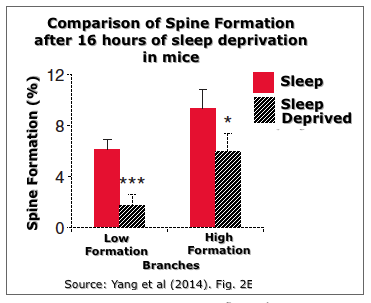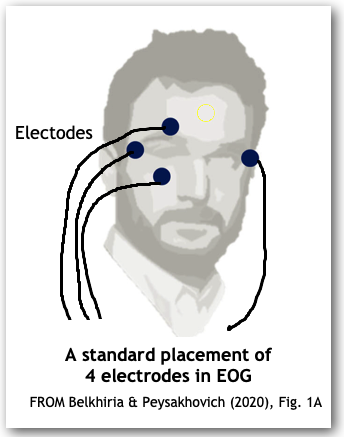![[Brain Image]](../graphics/head_space.gif)
PSY 340 Brain and Behavior
Class 24: Why Sleep? Why REM? Why Dreams? (OUTLINE)
|
|
PSY 340 Brain and Behavior Class 24: Why Sleep? Why REM? Why Dreams? (OUTLINE) |
|
A. Functions of Sleep
Why do we sleep? Short answer: we do not know (though we are getting closer)
- Note, too, that any theory of sleep in humans needs to consider why other animals sleep!
1. Sleep and Energy Conservation
Analogous to Sleep: Hibernation = body temp to just above freezing, brain activity almost nothing
- Small mammals
- Bears hibernate with body temperature only somewhat lower than normal (8-12º lower)
- Helps retard aging process & protects against infection & trauma.
Alternative sleep strategies in animals
2. Sleep and Memory
> long-term memories are strengthened (consolidation).
- Slow-wave sleep (SWS): Hippocampus-dependent episodic & spatial memory consolidation; verbal learning (e.g., memorizing lists of words)
- REM: Procedural (motor skills) and emotional memory
Some imaging studies suggest a replaying of learning sequences from the daytime and "weeding out" or pruning less important memory connections in brainSleeping after learning something usually results in memory gain upon awakening

n
Sleep may promote the development of new dendritic spines (new synapses) (see figures above)
Stage N2 sleep spindles (12-14 Hz): communication between thalamus & cerebral cortex associated with new learning. r = 0.7 with nonverbal IQ (i.e., explains 49% of variation!)
3. Sleep and Toxic Waste Removal (New, not in book)
- The brain has a system which channels cerebrospinal fluid (CSF) from tiny arteries through the actual brain tissue to veins which then remove the CSF. This has been called the glymphatic system.
- Research in 2013 found that, during sleep, the astrocytes in the brain shrink and create 60% more space through which the CSF can flow. Indeed the flow is about 10 times greater during sleep than the awake state. This permits the clearance of metabolic waste products such as amyloid-β, the waste material which accumulates in Alzheimer's disease.
- Research in 2025 found that "The brainstem releases tiny waves of norepinephrine once every 50 seconds during deep sleep. Those waves get blood vessels to contract and generate slow pulsations called vasomotions to create a rhythmic flow, which encourages the surrounding fluid to take the waste away."
B. Functions of REM Slee;p
- Longer sleep and higher %age of REM
- the human baby (REM: at birth, 50% of 22 hrs/day of sleep);
- at age 1 (30% of 17 hours/day of sleep)
- human adult (15-20% of 7-8 hours/day of sleep)
- REM may help in
- memory storage (as noted above)
- stimulating the developing nervous system of the infant & young child
- REM sleep deprivation leads to increased attempts at REM sleep subsequently
C. Biological Perspectives on Dreaming
- Complex dreaming develops as we get older (Domhoff, 2001; not in book)
- dreams of children < 5 yo are bland and static
- children < 10 yo report dreams only in about 20-30% of REM sleep
- adolescent/adult dreams are more dynamic & complex & dreams are reported in > 80% of REM sleep
- REM dreaming is different than NREM dreaming (not in book; Kandel et al., 2013)
- REM dreams: long, highly visual, often emotional, not often related to recent life experiences
- NREM dreams: short, non-visual, "conceptual" or thought-like, often related to recent life experiences
There is no single theory of dreaming which is now currently accepted by most psychologists.
Consider these four theories of what dreaming is about
Freud's Psychoanalytic Theory (1899/1900)
- Dreams as wish fulfillment
- Unconscious process constructs wish
- Censorship process distorts the wish via symbols et al.
- Each dream has two aspects
- Manifest content = what is remembered
- Latent content = underlying meaning of dream
- Dreams are interpreted within psychoanalytic therapy
Activation-Synthesis Hypothesis
J. Allan Hobson Initial theory (1997)
- Activation = during REM sleep, different brain areas, particularly the limbic system, become active under stimulation from the brain stem. These areas involve circuits related to emotion, memories, and sensations.
- Synthesis = the brain creates a story to make sense of the activity
Protoconsciousness Theory
J. Allan Hobson more recent theory (2000s)
- Brain activation in sleep allows the development & maintenance of circuits necessary for higher brain functions including consciousness
- In dreaming, we are getting ready to behave
- Dreams have more in common than not across individuals
- REM sleep = protoconscious state = provides a virtual reality model of the world that is of functional use to the development & maintenance of waking consciousness
Neurocognitive Theory of Dreaming
William Domhoff
- Underlying neural substrate for dreaming = Default Mode Network (DMN)
- Just as the DMN develops, so too do dreams develop as cognitive abilities mature, e,g., narrative or story abilities (see diagram on right)
- Adolescent/adult dreams reflect many of the real-life aspects of individuals, e.g., social networks or life settings
Lucid Dreaming [Not in our textbook]
Lucid dreaming is "a hybrid state of consciousness with definable and measurable differences from waking and from REM sleep, particularly in frontal areas" (Voss et al., 2009, Abstract].
- "Lucid dreaming refers to the phenomenon of becoming aware of the fact that one is dreaming during ongoing sleep... During lucid dreams individuals can be physiologically asleep while at the same time aware that they are dreaming, able to intentionally perform diverse actions, and in some cases remember their waking life" (Baird et al., 2019, p. 305)
- About 55% of all adults report having had at least one lucid dream and 23% report having regular lucid dreams, that is, at least once a month
- Training for Lucid Dreaming: Persons can be trained to enter into lucid dreams and participants in research are told to make a sequence of voluntary eye movements (usually, deliberately moving from right to left and in reverse) when they realize that they are in a lucid dream. The diagram below shows how this activity is clear in electro-oculograph readings of a sleeping person.

- Lucid dreaming seems to represent an intermediate state of consciousness between REM sleep (that usually involves a great deal of posterior cortical activity) and wakefulness (that involves significant activity of the frontal cortex of the brain).